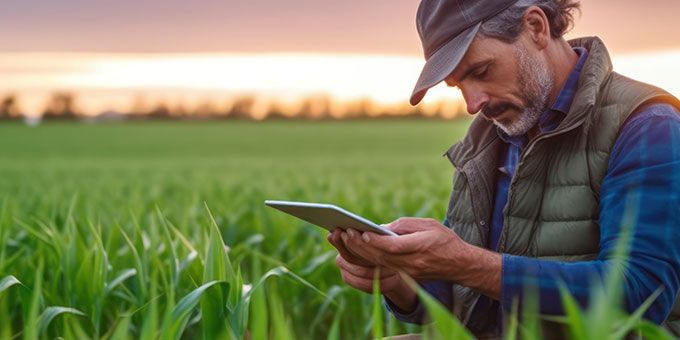Although we are seeing technology being introduced into the routine of many American farms, including robots, temperature and moisture sensors, aerial images and GPS technology, millions are either not able to, or unwilling to, invest in the solutions available.
 Precision Farming: Creating a ‘Networked Farm’ for the Future
Precision Farming: Creating a ‘Networked Farm’ for the Future

Michael Minchin, Product Manager, IoT | ST Engineering iDirect
Many industries today are leveraging the benefits of IoT (Internet of Things), enabling businesses to access real-time data, with valuable insights and remote monitoring/control capabilities.
The United States is one of its biggest investors, with businesses across the country predicted to invest up to $15 trillion in IoT solutions by 2025. One sector set to benefit from its capabilities is the US' agricultural market. This is an unpredictable industry, at the mercy of supply chain disruption, workforce decline, geopolitical uncertainty, and climate change.
Historically reliant on traditional, manual operations and processes, the agricultural industry is now experiencing a technological revolution. According to a McKinsey report, farmers are already noticeably embracing new products and technologies to manage market volatility. Precision Farming, supplemented by IoT technology, is at the forefront of that change.
The state of farming
According to the United Nations (UN) Food and Agriculture Organization, the world will need to produce 60 percent more food in 2050, in an effort to feed the world’s expanding population – which the UN forecasts will hit 9.7 billion by the same year. This demand places greater pressure on land and farmers who will now need to manage and enhance farm yield.
There’s also the problem of a rapidly declining agriculture workforce. The American Farm Bureau Federation estimates that there are, roughly, 2.4 million farm jobs that require filling each year, and applications are dwindling due to immigration challenges. Combined with the industry’s perceived disconnect from technology, a lack of profit and price – new farmers are discouraged from entering the industry.
While some believe the greatest threat to the farming discipline is technology and, as a result, automation, experts have suggested its biggest challenge is, in fact, the declining interest in it. In other words, we’re slowly losing the next generation of farmers.
As a result of this shrinking workforce, adoption of internet connectivity solutions in farming practices are on the rise, in order to reduce the need for manual labor.
There’s also the pandemic; the after effects of which will have, no doubt, further intensified the challenge farmers currently face – placing greater pressure on profit margins, sustainability and increasing the need for efficiency and speed. The pandemic also highlighted the necessity for more widespread digitization and automation in agriculture, along with many other industries.
These challenges are all occurring today against a tumultuous backdrop, as The United States Department of Agriculture (USDA) revealed its first 2024 cost-of-production forecast for major field crops. The report cited that current high production costs – the third-highest level ever – are set to stay throughout 2024.
Alongside its market predictions, the report also emphasized the importance of farm management factors such as risk management, marketing, diversification and production efficiency. These factors have a huge impact, enabling farmers to enhance income and reduce costs. While leaders in the industry understand that these challenges will require a concerted effort by governments and investors, many of these factors can be controlled by agricultural technologies and, importantly, IoT.
On the edge of digital transformation
IoT can play a fundamental role in business, beyond simply streamlining internal operations, managing remote assets and people.
A Harvard Business Review report claimed that IoT can change a business’ core strategy and business model. In fact, the report cited that 51 percent of businesses in the US had experienced enhanced customer service, 44 percent had seen increased revenue from services and/or products, while 38 percent had seen improved uses of assets in the field and 35 per cent had more information to feed big data/analytics efforts.
The significance of IoT is being felt across many sectors, all over the globe, yet the agricultural industry – described as the oldest industry in the world, remains just on the cusp of this change.
The last five decades, according to McKinsey, have seen enormous change across the sector, with advances in machinery improving scale, speed and productivity of farm equipment, and the introduction of chemical fertilizers and biotechnology. Now though, a new revolution is beginning to take shape, focused on data and connectivity to increase yields, elevate agricultural practices, reduce waste generation and, ultimately, boost profit margins.
Many farmers are turning to data to review essential variables like soil, crops, livestock and weather. Yet, few have access to advanced digital tools that would help turn this data into actionable insights. The most fundamental digital tool is access to a solid connectivity infrastructure.
Although we are seeing technology being introduced into the routine of many American farms, including robots, temperature and moisture sensors, aerial images and, in some cases, GPS technology, millions are either not able to, or unwilling to, invest in the solutions available. Lack of suitable connectivity in rural locations is a common barrier preventing investment in these optimal solutions.
The USDA reports that rural America includes 72 percent of the nation’s land, inhabited by a staggering 46 million people – this portion of land encompasses regions that focus heavily on agricultural production. It is these farmers who are unable, due to their remoteness, to benefit fully from suitable IoT connectivity.
Farmers have, historically, been unwilling to invest due to the perceived high cost of implementing agritech, and because the benefits, including a clear return on investment (ROI), have not been clear as a result of the market’s unpredictability. Most interestingly though, is that 50 percent of farmers are unwilling to invest at all.
If connectivity and IoT-enabled tech is implemented successfully, however, the US’ agricultural industry could see a further $500 billion in additional value to the global gross domestic product by 2030. Yet, despite technology’s obvious benefits, agriculture remains the least digitized industry compared with many others globally.
A ‘Networked Farm’
‘Precision Farming’ is a term that was initially theorized in the 1980s. It’s a strategy and support system that leverages new technology to generate data that informs decision making and predictive capabilities. Its implementation results in improvement in food production, through reduced waste and improved operational efficiencies, enabling a more sustainable farming model.
In its most basic form, it is a way to observe, measure and respond to change on the farm.
With its growing demand, IoT has become a must-have solution for the agricultural industry and an advancement that we’re slowly seeing more farmers adopt - for example, by placing IoT sensors in fields. Using connected IoT devices will help to determine nutrients and water deficits, provided by real-time data insights, which help to inform optimal planting and harvesting times, crop rotation and soil management.
Beyond the ground, IoT can also be utilized for livestock or asset tracking, to monitor health of farm animals and the performance of machinery. During my time working within the IoT space at ST Engineering iDirect, I’ve seen its impact touch all corners of the world - from counting cattle on large farms that span many hectares, to monitoring Kiwi birds under threat of extinction in New Zealand. It’s these kinds of novel ideas for IoT that make it such a fascinating market to be involved in.
IoT is heavily embedded within the Precision Farming strategy. And, while it’s proving fruitful for many, those remote farms - making up 72 percent of America and likely experiencing little to no terrestrial connectivity - aren’t going to truly reap the rewards.
This is where the ‘Networked Farm’ concept comes in.
For farmers with both small and large sites, satellite-based IoT and VSAT solutions provide the ideal connectivity tool to bridge the connectivity gap left by terrestrial technologies. Much like terrestrial IoT solutions, satellite-based narrowband and VSAT IoT solutions are already being used for a plethora of applications, from keeping detailed inventories and monitoring location, acreage, type and health of crop of livestock, to optimizing fertilization programs.
For example, IoT technology can be used on coffee plantations, where satellite-based solutions are used to create earth images that help predict, in a very accurate way, the level of NPK fertilizer that the farmer has to use.
The data provided helps to promote proper and targeted use of fertilizer, giving the farmer insight into which fertilizer to use, when to use it and how much. Not only does this promote a more sustainable method of farming, reducing greenhouse gases, it also helps them to lower costs as a result of better fertilizer management and, importantly, improve the quality of the farmer’s coffee yield.
IoT also provides a reliable source to manage the safety and security of crops, with abnormal activity tracked and early detection of wildfires quickly highlighted – a functionality of huge importance today, as the United States continues to see above average wildfires which have resulted in the country experiencing its worst toxic air pollution rates from wildfire smoke in recent history.
Another use case is the early wildfire detection, whereby sensors connected to a LoRa network and a VSAT Gateway collect the data on the temperature, wind and smoke, and pinpoint an area where a fire is starting and dispatch local fire fighters at the optimum time.
This technology is hugely beneficial for farmers, in particular – many of whom manage expansive areas and hundreds of animals - giving them the ability to access real-time information and act within seconds, giving them time to move livestock and machinery to safe areas.
Satellite technology transcends geographical or terrestrial limitations, offering unparalleled connectivity for the IoT, particularly for agricultural applications where other telecommunication methods fall short. Our suite of IoT solutions includes affordable, compact and data-efficient options in both Ku and Ka band, along with cost-effective VSAT packages. These offerings provide a spectrum of data solutions, from high-volume IoT data aggregation at a specific plant or site, to extremely data-efficient narrowband services, ideal for supporting IoT sensors spread across multiple remote locations.
A future for satellite-based IoT
As we continue to realize the range of opportunities that advanced technologies such as 5G, edge computing, automation, orchestration, and virtualization bring to the table, there’s an opportunity for the wider agricultural industry to level-up.
With high-volume production predicted to last throughout next year, demand for sustainable farming practices on the rise, and pressure to deliver produce for a growing population, farmers will need a reliable and connected solution at their disposal. One that delivers actionable insights, improves business efficiency, and raises security, in order to help future-proof America’s agricultural industry.
The content & opinions in this article are the author’s and do not necessarily represent the views of AgriTechTomorrow
Comments (0)
This post does not have any comments. Be the first to leave a comment below.
Featured Product


